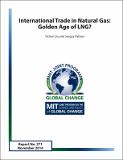International Trade in Natural Gas: Golden Age of LNG?
Author(s)
Du, Y.; Paltsev, S.
DownloadMITJPSPGC_Rpt271.pdf (2.976Mb)
Metadata
Show full item recordAbstract
The introduction of liquefied natural gas (LNG) as an option for international trade has created a market for natural gas where global prices may eventually be differentiated by the transportation costs between world regions. LNG’s trade share in 2013 was only about 30 percent of the total global trade in natural gas, but use of LNG is on the rise with numerous projects in planning or construction stages. Considering LNG projects that are under construction, planned, or proposed, we provide an analysis of LNG prospects for the next decade. LNG has substantial unexploited potential in terms of reducing capital requirements (especially for liquefaction projects), expanding new technology frontiers (e.g. floating LNG), serving new markets, and establishing new pricing schemes that better reflect the fundamentals of supply and demand. Trade volumes are projected to increase from about 240 Mt LNG in 2013 to about 340–360 Mt LNG in 2021. Despite potential challenges from weaker demand in Asia, longer-term projections show that LNG trade is bound to show substantial growth, partially due to geopolitical tensions that might increase LNG flows to Europe. However, these perspectives largely depend on demand choices, the availability and evolution of alternative fuels (e.g. renewable energies), and—most importantly—political decisions framing economic behavior.
Date issued
2014-11Publisher
MIT Joint Program on the Science and Policy of Global Change
Citation
Report 271
Series/Report no.
MIT Joint Program Report Series;271